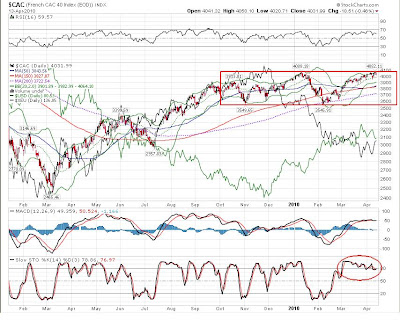April 13, 2010 : Global Equity Picture
Before we begin, it appears that last night's call of a beginning of a (short lived) dollar rally and gold pullback was spot on. Here's a secret. In addition key currencies testing support and resistance levels (the euro, the dollar, and gold, among others), there was a turn in the dollar as forecasted by our proprietary short term cyclical model:
Though based on a Hilbert Transform, it has a few additional properties to better call tops, bottoms, and turns. Note that in the chart, the most recent green line is generated mathematically, and began yesterday, before the rally. This should serve as the dollar's bottom (as measured by the UUP ETF) for this rally. We believe that it will probably run a half cycle as a top and turn lower. If you follow the blog for the next few weeks, you'll get a better understanding of what we're referring to. If the dollar breaks down below this point in the next few days, it will strongly suggest that the dollar has resumed a bear market trend.
Today, we'll focus on global equities. Generally speaking, equities are largely overbought globally. However, as many longer term readers may recall, the typical bear market rally lasts 22 months. From March of 2009, that implies a January 2011 point when equities resume their bear markets. We've been of the belief that equities would begin to turn lower at the end of Q2/2010, or perhaps early Q3. At this stage, given how virtually everyone is expecting equities to roll over just any day now, we're inclined to give the benefit of the doubt to the rally. The bears must prove themselves. Thus far, they're falling short. There are a few tried and true ways of defining the beginning of a bear market--we'll stick to those technicals and make the market prove its bearishness. The trend is your friend--except when it bends, round the ends...
Let's cut to the chase on this one. Global equities are overbought short to intermediate term. They're due for a pullback. However, the intermediate to longer term appears to be positive. Note that since summer of 2009, we've had a call for a potential 1350 on the S&P 500. Are stocks overvalued? Yes. Is a market valuation like that virtually crazy? Yes. But, as James Dines once said, (and I paraphrase) we should look at the charts and not think too much...
Global equities are closely tied together. Take a look. Only minor commentary is necessary.
The S&P 500 is overbought technically, but refuses to turn down. Is the Fed buying futures? Pumping money into the system near options expiration week? Who cares? Valuations are terrible and the market will likely correct strongly. Near term, it's due for one. Will it be a strong correction? We'll only know after the fact. At this stage, the S&P 500 is poised during the intermediate and longer term for a rise.
What about Asia's powerhouse, China? Is it a bubble? Will it crash? Is it due to come down soon?
The Shanghai Stock Exchange is in a symmetrical triangle, just waiting for a break one direction or the other. Global markets depend on it breaking upward. Will it? Time will tell. The trend is your friend...except when it bends, round the ends...
The Indian market is consolidating. It's overbought. Will it definitively break out? Stay tuned..
The Aussie market's in much the same position...
Canada appears to be setting a more positive trajectory, with consistent bounces from the 50 dma.
Brazil is consolidating...
So is France, even in the wake of European debt issues...
Germany, with its export-driven economy, appears to want to continue to move up, though it may retreat to support soon.
In summary, global equity markets are technically overbought in general, but there is no technical indication that a serious breakdown is due any time soon. Generally speaking, the rate of climb has slowed, but the positive trajectory continues. It is very, very, very rare that stock crash without some form of technical warning. Not even the 2007 global equity markets crashed without many very visible signs. Though these markets are generally overbought, barring a black swan event, they are poised to correct and move higher. And...if you're betting on black swans...the odds are not in your favor.
Send us an email if you're interested in something specific. Without a growing audience, there's little interest in continuing a blog. Send us an email if you'd like coverage of something specific. Read more...





























